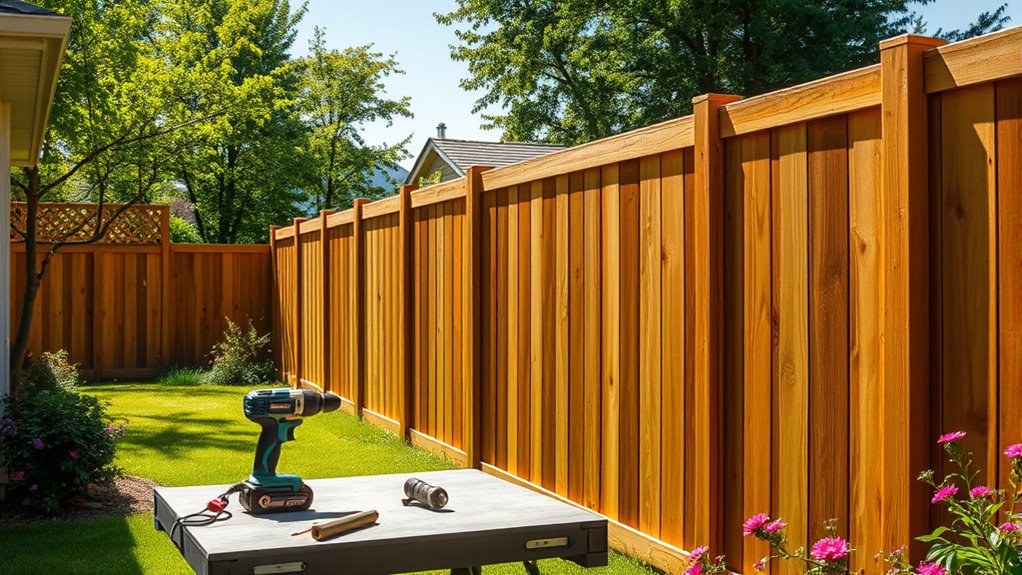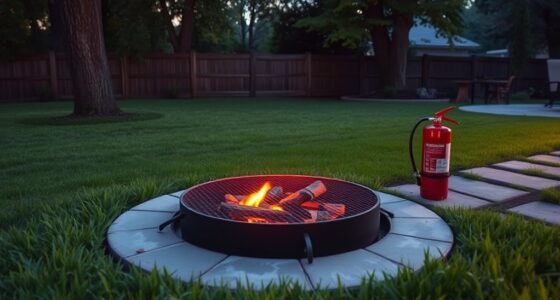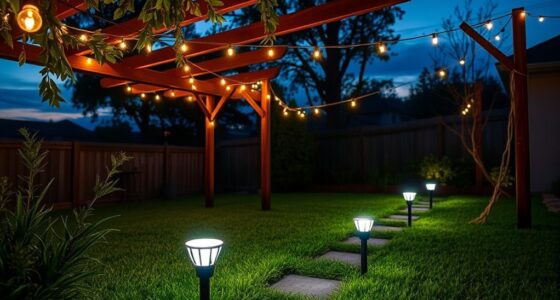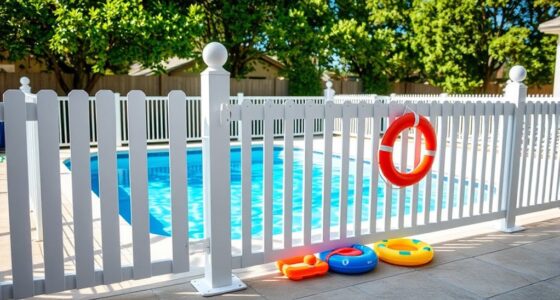Installing a privacy fence offers benefits like increased security, noise reduction, and enhanced privacy, while also boosting your property’s curb appeal. However, it can be costly, requires regular maintenance, and might face restrictions from local regulations or HOAs. To guarantee a long-lasting, effective fence, plan carefully, choose the right materials, and follow proper installation steps. Keep in mind the tips for maintenance, and you’ll maximize your fence’s lifespan—discover more about making your project successful as you continue.
Key Takeaways
- Privacy fences enhance security and seclusion but may require permits and adherence to local regulations.
- They can increase property value but involve significant upfront costs and ongoing maintenance.
- Choose durable materials like vinyl or wood for longevity, considering climate and budget.
- Proper installation with accurate measurement, level posts, and secure supports ensures fence durability.
- Regular maintenance, such as sealing and inspecting fasteners, extends the lifespan and preserves privacy.

Installing a privacy fence can greatly enhance your outdoor space by providing seclusion, security, and noise reduction. Before you start, it’s vital to verify local regulations, homeowners association rules, and property lines to avoid legal issues. Knowing your property boundaries ensures you build within your lot and prevents disputes. Measure and mark the fence layout accurately using string lines to keep everything straight and aligned. Carefully selecting your fence materials is essential; consider durability, cost, and privacy needs when choosing between wood, vinyl, or metal. Gathering all necessary tools and materials beforehand, like a post hole digger, concrete, screws, and rails, streamlines the process and minimizes delays. Additionally, always check for underground utilities before digging post holes to prevent accidents or damage.
Enhance your outdoor space with a privacy fence—plan carefully, choose quality materials, and follow proper installation steps.
When digging post holes, aim for about one-third of the post length—typically 2 feet deep for 6-foot posts. Use gravel or sand at the bottom of each hole to improve drainage and extend the life of your posts. Place the posts plumb and level within the holes, ensuring they are straight and properly aligned. Pour concrete mixed with the right water ratio around each post, then allow it to dry completely before attaching any rails or panels. This provides a solid foundation for your fence, preventing shifting or leaning over time. Proper planning and measurement are crucial to ensure your fence remains straight and sturdy over the years. Additionally, understanding the importance of proper drainage can help prevent water damage and extend the lifespan of your fence structure.
Next, attach three horizontal rails — bottom, middle, and top — to support your fence panels or pickets. Use weather-resistant screws or nails to fasten the rails securely to the posts, ensuring stability and longevity. Measure and mark for the rails carefully, especially on uneven terrain, to maintain levelness and uniform appearance. Consider using rail brackets for added support, making installation easier and more precise. Once the rails are firmly in place, install your panels or pickets, keeping their spacing and height consistent. Starting at a corner or gate post can help with alignment, and make sure each panel is straight and securely fastened.
For gate installation, use the same procedures as for the fence posts, ensuring they are sturdy enough to support the gate’s weight and movement. Measure, predrill, and attach hinges carefully for smooth operation. Install suitable locking mechanisms based on your security needs and test the gate to confirm it opens and closes smoothly before completing the setup. Regular maintenance extends your fence’s lifespan—treat wood with sealants or stains to resist weathering, inspect for loose fasteners or damaged sections, and clean periodically to prevent mold and dirt buildup. Keep vegetation trimmed at the base to prevent moisture damage, and promptly repair or replace damaged sections to preserve your fence’s privacy and structural integrity.
A well-installed privacy fence offers numerous benefits, from visual shielding and noise reduction to increased security. It’s a worthwhile investment that, with proper planning, precise execution, and ongoing maintenance, will serve you well for years to come.
Frequently Asked Questions
What Are the Best Materials for a Privacy Fence?
When choosing the best materials for a privacy fence, consider durability, maintenance, and cost. Cedar offers natural resistance and longevity, while vinyl provides low maintenance and weather resistance. Composite fences combine the look of wood with added durability, reducing upkeep. If you’re on a budget, pressure-treated pine or spruce work, but they’ll need regular care. Ultimately, select a material that matches your aesthetic, climate, and maintenance preferences for lasting privacy.
How Much Does a Privacy Fence Typically Cost?
You might think a privacy fence costs too much, but the truth is, prices range from $10 to $60 per linear foot depending on materials and location. For a 150-foot fence, expect to spend around $4,300 to $5,000. Factors like height, material, and terrain influence the final cost. By comparing quotes and choosing standard designs, you can find a solution that fits your budget and privacy needs.
Are There Any Legal Restrictions on Fence Height?
You should know that legal restrictions on fence height vary widely depending on your city or county. Typically, residential fences range from 6 to 8 feet, but front yard fences are usually limited to 3-4 feet. You might need a permit for taller fences, especially if they exceed 6 feet. Always check local zoning laws, deed restrictions, and HOA rules before building to avoid fines or violations.
How Long Does It Take to Install a Privacy Fence?
You might think installing a privacy fence always takes days, but it actually varies. In ideal conditions, a professional team can complete it in 2 to 5 days, depending on size and material. For example, chain link fences go up in a day, while wooden fences may take closer to four. Factors like terrain, weather, and the fence’s complexity influence the timeline, so plan accordingly for your project.
What Maintenance Is Required for Different Fence Types?
You need to know that different fence materials require specific maintenance. With wood, you’ll stain and seal regularly to prevent rot and insects. Vinyl fences need just occasional cleaning with soap and water. Aluminum fences require periodic cleaning, while chain-link fences need tightening and cleaning. Regular inspections, prompt repairs, and seasonal cleaning help keep your fence in good shape and extend its lifespan, no matter the material.
Conclusion
Installing a privacy fence is like planting a sturdy shield around your home, offering security and peace of mind. While it comes with costs and maintenance, the benefits of privacy and added value often outweigh the drawbacks. Think of it as a trusted guardian, silently watching over your sanctuary. With the right planning and care, your fence will stand tall and strong, turning your outdoor space into a private retreat that feels as safe as a fortress—your personal haven.









